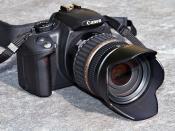In a very short period of time professional photographers have suddenly found a vast amount of advanced photographic equipment and new technology at their disposal.
Although innovation and development in the silver halide market has been slow, digital imaging technology has been advancing rapidly. The most dramatic of the changes has been in the digital camera's ability to capture better image quality and resolution, and the technology for creating high quality digital prints.
Suddenly there are many more choices for the photographer and new skills to aquire. Film-based photography and digital photography both have their own advantages and disadvantages . A new skill for photographers to have would be to understand the best method of capturing an image for a chosen task.
Digital and film-based photography are both means to an end, which is to capture an image. Digital cameras have lenses and shutters which work in much the same way as traditional ones.
The big difference is the way in which the image is captured and stored.
Digital and traditional photographers have many of the same concerns, such as lighting and shadows and exposure control. Digital photographers also have to know about things such as image file formats, monitor calibration, pixels per inch and other concepts. In fact it means more than just cameras and lighting, it means becoming involved in the whole process that takes place.
The ' I am just a photographer ' attitude fades and the digital photographer can focus on image control and creative possibilities. The photographer can experiment without the worry of the cost of the film.
Taking photographs digitally follows a more direct path to capturing images than taking them with film. The photographer can view the image on their monitor and enlarge any area to check for focus and detail. Contrast and...

